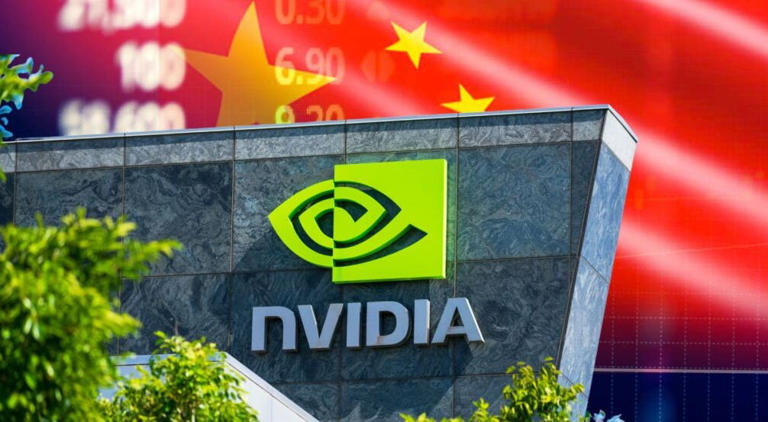Nvidia China Market Controls: CEO Voices Major Concerns

Nvidia China market controls have become a pressing issue for the tech giant, as CEO Jensen Huang recently expressed concerns over the significant revenue losses resulting from stringent export restrictions on AI chips. During a recent earnings call, Huang revealed that Nvidia missed out on an estimated $2.5 billion in potential revenue due to the inability to sell its H20 processor to the Chinese market. He emphasized that while the company achieved remarkable growth overall, the closure of the $50 billion Chinese market to U.S. industry poses serious challenges. Huang’s remarks echo wider fears in the tech community about how AI chip export restrictions are reshaping market access and revenue projections for companies like Nvidia. As the situation evolves, the Nvidia revenue impact remains to be seen, with concerns mounting about China’s growing internal capabilities amidst these restrictions.
The challenges surrounding Nvidia’s access to the Chinese market reflect broader themes in global tech dynamics. With heightened export controls on AI technology, Nvidia faces limitations that are reshaping its operational landscape. Huang’s comments resonate not just with Nvidia’s situation, but also highlight a larger narrative about the competitive nature of AI development in international markets. As China rapidly advances its own semiconductor capabilities, the impact on U.S. firms could be substantial, provoking debates about national security and the tech race. Ultimately, the ongoing discourse underscores the delicate balance between innovation, market access, and regulatory measures in the evolving landscape of global technology.
Nvidia’s Revenue Loss Due to AI Chip Restrictions
Nvidia has reported a significant revenue shortfall attributed to the inability to sell AI chips in the crucial Chinese market. In their latest earnings call, CEO Jensen Huang emphasized that the company left $2.5 billion in potential gains unearned due to the abrupt imposition of export controls on the H20 chips. This restriction not only affects Nvidia’s finances but also signals a troubling trend for American technological exports to China, a market valued at $50 billion. Huang’s stark statement highlights the depth of the issue, revealing that the U.S. industry is effectively shut out from engaging with one of the world’s fastest-growing sectors.
The situational analysis reflects a broader impact beyond just Nvidia’s balance sheet; it underscores the potential shift in technological leadership. Huang pointed out that while Nvidia’s innovative capabilities are indeed impressive, China is likely to pivot toward its own domestic solutions, thereby reducing reliance on U.S. AI chips. This development poses a dual challenge, as not only does it hit Nvidia’s revenues, but it also accelerates the pace at which China could catch up in advanced technologies, leaving implications for future U.S. competitiveness in the sector.
Huang’s Perspective on China’s AI Landscape
In the context of growing tensions between the U.S. and China, Jensen Huang’s insights into the Chinese AI market are particularly compelling. He argues that the U.S. government’s assumption that China lacks the capability to produce advanced AI chips is fundamentally flawed. Huang candidly stated, “The issue is not whether China will have AI; it already does.” This assertion not only critiques the prevailing narrative underpinning export restrictions but also paints a picture of a rapidly evolving technological ecosystem in China that U.S. companies must navigate tactically.
Huang further articulated that Chinese AI researchers would likely turn to domestic options and competitors like Huawei in response to U.S. export restrictions. As a consequence, the technological gap that America aims to maintain might close faster than anticipated. The implications of such a scenario are significant, as the balance of power in AI research and development could shift, fostering new players in the global technology arena. This situation challenges Nvidia and other tech leaders to rethink their strategies for engaging with China, a market that remains critical despite the geopolitical complexities.
Strategic Responses to Export Controls
In light of the stringent U.S. export controls, Nvidia is evaluating its strategies regarding chip production and market access. CEO Huang noted that the company does not currently have alternative products specifically tailored for the Chinese market, indicating a significant gap in strategic planning following the latest regulatory changes. The loss of anticipated H20 sales has not only resulted in a $4.5 billion inventory write-off but also casts doubt on Nvidia’s future revenue trajectory. This predicament highlights the need for strategic foresight in navigating international markets amid evolving governmental policies.
Moreover, Huang’s comments hint at broader implications for the tech sector as a whole; he acknowledged the necessity for U.S. companies to adapt to changing dynamics influenced by domestic and international politics. While expressing support for the current administration’s focus on promoting American manufacturing, Huang also underscored that finding a workaround to the restrictions imposed by U.S. authorities remains a challenge. His balancing act of maintaining a positive relationship with government officials while voicing the impact on business outcomes reflects the complex environment in which tech companies operate today.
The Future of AI Chips in Global Markets
As Nvidia confronts the challenges posed by export controls, the future of AI chips in global markets remains uncertain. The ongoing restrictions could catalyze a shift in AI chip production toward more localized solutions, particularly in China. Huang’s remarks about Chinese researchers increasingly turning to domestic alternatives signal a critical juncture for American tech firms. This change may prompt Nvidia to reassess its research and development strategies to remain competitive in an environment where swift technological advancements are the norm.
Additionally, the larger implications of these export controls extend beyond Nvidia. If competitive pressures especially in AI and chip manufacturing spring up from companies in emerging markets like China, U.S. firms may need to significantly ramp up innovation and optimize their market strategies. Failure to adapt could result in a loss of market share not just in China, but globally. The landscape may soon be defined by new entrants who are undeterred by export restrictions and prepared to meet both domestic and international demands.
National Security and Trade Implications
The intersection of national security and trade policies is prominently at the forefront of Nvidia’s challenges in the China market. Huang pointed out that the U.S. government’s export controls stem from heightened national security concerns regarding advanced technologies. As tensions between the two nations escalate, the idea of restricting access to critical tech products tools like Nvidia’s AI chips is employed as a safeguard against potential national threats. However, this national security paradigm may inadvertently hinder U.S. tech firms’ competitiveness in key international markets.
As the global tech landscape evolves, the balancing act between safeguarding national interests and promoting economic growth becomes increasingly complex. Nvidia’s situation illustrates how stringent regulations can adversely affect major U.S. players, driving them to reconsider their market engagement strategies. Huang’s insights serve as a cautionary tale for policymakers: excessive restrictions may lead to isolated innovation and reduced influence in rapidly growing technological spheres, such as AI and semiconductor manufacturing, particularly in regional powerhouses like China.
Huang’s Comments on U.S.-China Relations
Jensen Huang’s comments reflect a nuanced understanding of U.S.-China relations, especially as they pertain to technological advancements and economic competitiveness. As the CEO notes, the current restrictions on AI chip exports not only impact Nvidia’s business but also shape the larger narrative surrounding U.S. innovation capabilities. Huang’s approach emphasizes the necessity for constructive dialogue between government entities and the tech industry to navigate the challenges posed by export regulations.
Huang’s statements also underscore a need for clarity and adaptability within U.S. economic strategies. While he expressed appreciation for certain policies enacted by the Trump administration, he articulated the pressing need for reevaluating restrictive measures that could ultimately hinder American technological progress. Striking a balance between protecting national security and fostering economic relationships with critical markets like China may be crucial for the continued success of U.S. tech firms.
Nvidia’s Position in the AI Industry Landscape
Nvidia’s pivotal position within the AI chip industry is threatened by external geopolitical forces, particularly given the current export restrictions. With the company reporting a remarkable revenue growth despite the challenges, it indicates a robust demand for AI capabilities. However, Huang’s warnings about the impending closure of the China market juxtapose this growth narrative with the stark realities of operating in such a politically charged environment. Nvidia’s future in the AI industry could be shaped by its ability to innovate while overcoming market access hurdles.
Furthermore, the implications of Nvidia’s challenges in China extend across the tech sector. Competitors may gain ground as they adapt to regional demands without facing the same restrictions. Huang’s acknowledgment of the necessity for U.S. technology firms to maintain competitive edges amidst rising Chinese capabilities emphasizes the urgency for innovation-focused strategies. The question remains whether Nvidia can bolster its position by streamlining production and exploring alternatives that align with evolving market landscapes.
Long-term Consequences of Export Restrictions
The long-term consequences of export restrictions on AI technologies promise to reshape the landscape of global tech, with Nvidia at a crossroads. These restrictions could catalyze an environment where innovation is decentralized, empowering countries like China to develop indigenous technologies at an accelerated pace. Huang’s insights reflected major industry concerns regarding how these policies might inadvertently enhance China’s tech capabilities, moving toward self-reliance in areas where they previously depended on U.S. imports.
Moreover, understanding the potential long-term financial ramifications for Nvidia and similar companies is crucial. The financial impact of lost sales, inventory write-offs, and shareholders’ expectations could force firms to diversify their markets or innovate their technologies to remain competitive. As Huang articulates the urgency for adjustments, it becomes evident that not only Nvidia’s fate hangs in the balance but also the broader trajectory of the American tech sector in a globally competitive environment.
Navigating Future Trade Policies
As the Technological landscape evolves, Nvidia must navigate the complexities of future trade policies that will dictate the ease of market access, especially concerning China. CEO Jensen Huang’s remarks highlight the importance of remaining agile amidst these shifting regulations. The company has to not only prepare for potential changes in government policies but also strategically engage with policymakers to advocate for beneficial frameworks that can enable smoother tech transfers.
In this pursuit, Nvidia might explore avenues for collaboration with lawmakers to find practical solutions that address national security concerns without stifling the innovation potential of American companies. By forging partnerships and aligning interests with influential policymakers, Nvidia could safeguard its business model while helping shape a landscape that promotes healthy competition globally.
Frequently Asked Questions
What are Nvidia’s China market controls and how do they impact sales?
Nvidia’s China market controls refer to the export restrictions imposed by the U.S. government on advanced AI chips, such as the H20 series. These controls effectively limit Nvidia’s ability to sell its products to the Chinese market, resulting in an estimated $2.5 billion in potential lost revenue in a single quarter. The restrictions are driven by national security concerns, impacting not only Nvidia’s financial performance but also the broader U.S. market’s competitiveness.
How did Nvidia CEO Jensen Huang respond to the export restrictions affecting China?
Nvidia CEO Jensen Huang expressed significant dissatisfaction with the constraints imposed on the company’s ability to access the China market. He highlighted that the restrictions prevent Nvidia from realizing potential revenue, amounting to a $2.5 billion shortfall from sales that could have stemmed from the H20 chip. Huang noted that these controls may push Chinese AI researchers to seek alternatives like domestic chips from companies such as Huawei, indicating a shift in the competitive landscape.
What is the expected revenue impact of Nvidia’s inability to sell chips in China?
Nvidia projects a notable impact on its revenue due to the inability to sell its H20 chips in China. During an earnings call, Huang indicated that revenue could have been about 18% higher in the current quarter without these restrictions, showcasing the financial toll of being unable to tap into the $50 billion Chinese market.
What are the implications of Huang’s comments on China’s AI chip production?
Huang’s comments suggest that China’s advancement in AI chip production is more robust than previously assumed. He pointed out that the U.S. policy might underestimate China’s capabilities, stating that ‘the issue is not whether China will have AI; it already does.’ This implies that even with export restrictions, China is likely to continue developing its AI technology independently.
What future strategies does Nvidia have concerning the China market amidst export controls?
Currently, Nvidia does not have a clear strategy or alternative product aimed specifically at the China market due to stringent U.S. export controls, as stated by Jensen Huang. Despite his frustrations, Huang recognizes that the U.S. government has a plan regarding AI technology exports, but he withheld details on how Nvidia might navigate this complex landscape moving forward.
| Key Points | Details |
|---|---|
| Nvidia’s Loss of Revenue | Nvidia lost $2.5 billion in potential revenue due to export controls preventing sales of H20 chips to China. |
| Effect of Export Controls | CEO Jensen Huang stated that the $50 billion China market is effectively closed to U.S. companies, requiring a substantial write-off of unsellable inventory. |
| Impact on AI Development | Huang believes that export controls could have detrimental effects on the U.S. industry’s competitive edge, with China progressing independently in AI technology. |
| Nvidia’s Performance | Despite the challenges, Nvidia reported a 69% revenue growth year-over-year, reaching $44 billion, outperforming analyst expectations. |
| Future Outlook | Nvidia faces cancellation of $8 billion in planned H20 orders and projects a revenue guidance that could have been significantly higher. |
Summary
Nvidia China market controls have led to significant financial implications for the company, with CEO Jensen Huang revealing that the restrictions have closed off a lucrative segment of the market. The inability to sell H20 chips to China resulted in substantial unearned revenue and inventory write-offs, showcasing how export controls not only hinder Nvidia but also risk the competitive landscape of U.S. tech. As China advances in AI despite these barriers, the industry must reconsider its approach to international trade and market access.




